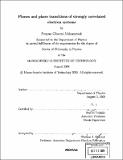Phases and phase transitions of strongly correlated electron systems
Author(s)
Ghaemi Mohammadi, Pouyan
DownloadFull printable version (9.940Mb)
Other Contributors
Massachusetts Institute of Technology. Dept. of Physics.
Advisor
Senthil Todadri.
Terms of use
Metadata
Show full item recordAbstract
Different experiments on strongly correlated materials have shown phenomena which are not consistent with our conventional understandings. We still do not have a general framework to explain these properties. Developing such a general framework is much beyond the scope of this thesis, but here we try to address some of challenges in simpler models that are more tractable. In correlated metals it appears as strong correlations have different effect on different parts of fermi surface. Perhaps most striking example of this is normal state of optimally doped cuprates; the quasiparticle peaks on the nominal fermi surface do not appear uniformly. We try to track such phenomena in heavy fermion systems, which are correlated fermi liquids. In these systems, a lattice of localized electrons in f or d orbitals is coupled to the conduction electrons through an antiferromagnetic coupling. Singlets are formed between localized and conduction electrons. This singlet naturally have non-zero internal angular momentum. This nontrivial structure leads to anisotropic effect of strong correlations. Internal structure of Kondo singlet can also lead to quantum Hall effect in Kondo insulator, and formation of isolated points on the fermi surface with fractionalized quasiparticles. In the second part we study a phase transition in Heisenberg model between two insulating phases, Neel ordered and certain spin liquid state, popular in theories of the cuprates. The existence of such a transition has a number of interesting implications for spin liquid based approaches to the underdoped cuprates and clarifies existing ideas for incorporating antiferromagnetic long range order into such a spin liquid based approach. This transition might also be enlightening, despite fundamental differences, for the heavy fermion critical points where a second order transition between the heavy fermion phase and a metallic phase with magnetic antiferromagnetic order is observed.
Description
Thesis (Ph. D.)--Massachusetts Institute of Technology, Dept. of Physics, 2008. Includes bibliographical references (leaves 169-174).
Date issued
2008Department
Massachusetts Institute of Technology. Department of PhysicsPublisher
Massachusetts Institute of Technology
Keywords
Physics.